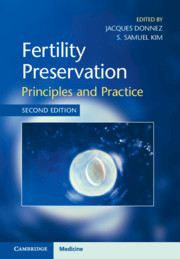Book contents
- Fertility Preservation
- Fertility Preservation
- Copyright page
- Dedication
- Contents
- Contributors
- Foreword
- Foreword
- Preface
- Section 1 Introduction
- Section 2 Reproductive Biology and Cryobiology
- Section 3 Fertility Preservation in Cancer and Non-Cancer Patients
- Section 4 Fertility Preservation Strategies in the Male
- Section 5 Fertility Preservation Strategies in the Female: Medical/Surgical
- Section 6 Fertility Preservation Strategies in the Female: ART
- Section 7 Ovarian Cryopreservation and Transplantation
- Section 8 In Vitro Follicle Culture
- Section 9 New Research and Technologies
- Section 10 Ethical, Legal, and Religious Issues
- Index
- References
Section 1 - Introduction
Published online by Cambridge University Press: 27 March 2021
- Fertility Preservation
- Fertility Preservation
- Copyright page
- Dedication
- Contents
- Contributors
- Foreword
- Foreword
- Preface
- Section 1 Introduction
- Section 2 Reproductive Biology and Cryobiology
- Section 3 Fertility Preservation in Cancer and Non-Cancer Patients
- Section 4 Fertility Preservation Strategies in the Male
- Section 5 Fertility Preservation Strategies in the Female: Medical/Surgical
- Section 6 Fertility Preservation Strategies in the Female: ART
- Section 7 Ovarian Cryopreservation and Transplantation
- Section 8 In Vitro Follicle Culture
- Section 9 New Research and Technologies
- Section 10 Ethical, Legal, and Religious Issues
- Index
- References
- Type
- Chapter
- Information
- Fertility PreservationPrinciples and Practice, pp. 1 - 34Publisher: Cambridge University PressPrint publication year: 2021

